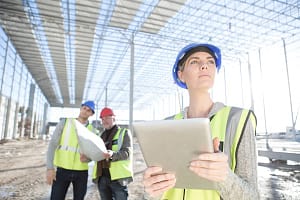The office is no longer a static space—it’s a living system. As hybrid work becomes the dominant model, companies are rethinking what their physical spaces mean, how often they’re used, and how those spaces can better serve both employees and business goals. Gone are the days when office planning was based on headcount and square footage. Today, data is the new blueprint guiding how organizations design, manage, and measure the value of their work environments.
Modern enterprises are leveraging real-time data—on occupancy, collaboration patterns, and energy usage—to build workplaces that flex with employee behavior. This shift represents more than a design trend; it’s a data-driven reformation of corporate real estate, one that aims to make hybrid work sustainable, efficient, and employee-centric.
From guesswork to measurable efficiency
Traditionally, office utilization was measured through periodic audits and broad assumptions. Facilities teams relied on badge swipes, desk reservations, and simple observation to estimate space usage. The results were often misleading. Post-pandemic, as companies adopted flexible schedules, utilization rates became far more variable.
Now, organizations are replacing assumptions with sensor-driven and analytics-based approaches. Motion sensors, Wi-Fi tracking, and booking data feed into advanced dashboards that visualize how employees interact with space—by hour, by zone, and by function.
These insights empower leaders to make data-backed decisions: downsizing underused floors, converting static workstations into collaboration hubs, or introducing quiet zones when concentration dips are detected.
As Thomas O’Shaughnessy, President of Consumer Marketing at Clever Offers, explains: “Real estate is no longer about square footage, it’s about behavior patterns. Companies that treat space as a measurable performance asset, not a fixed cost, are finding new ways to cut overhead while improving employee experience.”
This mindset shift—from occupancy to outcomes—is driving the next evolution of corporate real estate management.
Data is powering the new hybrid office design
The rise of hybrid work has created an unexpected design challenge: how to build spaces that adapt to unpredictability. Monday might look like a full house, while Friday feels like a ghost town. To counter this, companies are turning to predictive analytics to forecast workspace demand.
AI-powered tools integrate calendar data, meeting trends, and even commute patterns to predict when and how spaces will be used. For example, a company can identify that mid-week collaboration spikes between marketing and product teams—and reconfigure rooms to support cross-functional brainstorming during those times.
Data also informs zoning strategies. Instead of assigning fixed desks, companies are using dynamic zoning to allocate space types—focus areas, team pods, or project-based rooms—based on real-time utilization insights. These patterns are then fed into long-term design models, influencing how future offices are constructed or leased. As Suhail Patel, Director at Dustro, explains, “Data turns the workspace into a feedback loop. You measure how employees use it and evolve accordingly, keeping hybrid teams connected without wasting space.” In short, the hybrid office of tomorrow isn’t designed once—it’s designed constantly.
Integrating employee experience data
Space analytics alone don’t tell the full story. True optimization requires linking physical usage data with human experience metrics—like engagement, satisfaction, and collaboration quality. Companies are now combining workplace sensors with surveys, app analytics, and productivity data to gain a 360-degree view of how environments influence performance.
For instance, if collaboration data reveals that employees spend less than 20% of their time in team meetings, while survey feedback shows low connection scores, the data correlation might indicate a design gap: perhaps team zones are too far apart or meeting areas are too few.
This combination of quantitative and qualitative insights is shaping how businesses balance flexibility with belonging. Modern workplace platforms, such as OfficeRnD and Mapiq, merge these data streams to help companies personalize the office experience—whether by suggesting optimal workdays for team overlap or automating desk allocation based on team size and project type. As Jeffrey Zhou, CEO and Founder of Fig Loans, explains, “Smart companies know hybrid space data isn’t just about efficiency; it’s about empathy. Tracking who shows up is easy, but understanding why helps create workplaces that serve people, not policies.” This people-centered interpretation of space data is redefining workplace strategy across industries—from finance and tech to logistics and healthcare.
Energy, cost, and sustainability analytics
Another major benefit of hybrid space data is its impact on cost optimization and sustainability goals. With fluctuating occupancy, traditional building systems—lighting, HVAC, and cleaning schedules—often remain fixed, leading to waste.
Smart buildings now integrate IoT energy sensors that adjust automatically to real-time usage. When fewer employees are on-site, systems scale down, lowering both operational costs and carbon footprints. According to CBRE’s Global Occupier Sentiment Survey, organizations using occupancy analytics have reduced energy expenses by up to 30% while enhancing ESG reporting accuracy.
This alignment of sustainability and savings makes data an indispensable tool for modern real estate leaders. It also strengthens the case for adaptive leasing, where companies rent flexible square footage tied to actual utilization metrics. As hybrid work patterns stabilize, this variable-cost model could replace traditional long-term leases for many global enterprises.
The rise of space-as-a-service
With precise utilization data at their fingertips, many companies are rethinking ownership altogether. Enter the “space-as-a-service” model—a concept borrowed from the cloud economy. Instead of committing to rigid leases, businesses now subscribe to modular workspace providers that can flex up or down based on weekly or quarterly demand.
Data analytics make this model possible by quantifying needs with confidence. A multinational firm, for example, can identify underused regional offices and shift resources to high-collaboration hubs without compromising productivity. These adjustments occur in near real-time, informed by actual usage trends rather than managerial intuition.
By merging operational agility with financial control, data-driven real estate strategies are making hybrid work economically viable—not just culturally desirable.
The future: Real-time workplaces and AI-driven planning
The next phase of hybrid workplace evolution will be fully autonomous. AI will orchestrate space usage dynamically—predicting attendance, managing energy, and allocating rooms before employees even arrive. Digital twins of office environments will simulate space performance, identifying inefficiencies before they occur.
Meanwhile, data privacy and ethics will remain central concerns. As organizations collect more granular information—from desk sensors to employee presence data—balancing transparency with trust will determine adoption success.
In this emerging landscape, the role of corporate real estate leaders is shifting from administrators to strategists—curators of experience, efficiency, and empathy. Their success will hinge on how intelligently they translate data into design decisions.
Conclusion: The new workplace intelligence
Hybrid work has shattered the old logic of office planning, but data has rebuilt it smarter. The companies leading this transformation understand that real estate is no longer a cost center—it’s a living metric of organizational health.
By merging behavioral insights, sustainability analytics, and employee experience data, they’re crafting hybrid spaces that are leaner, greener, and more human. The future of work won’t be measured by square footage—it will be measured by how intelligently every inch of that space empowers people to do their best work.






Leave a Comment